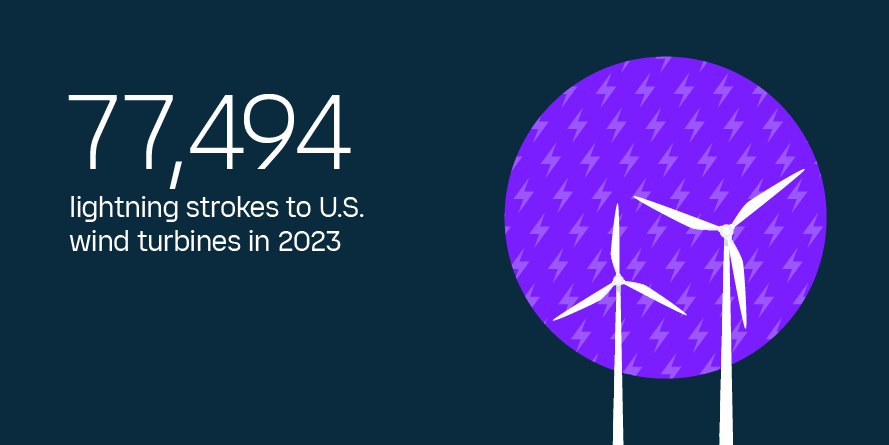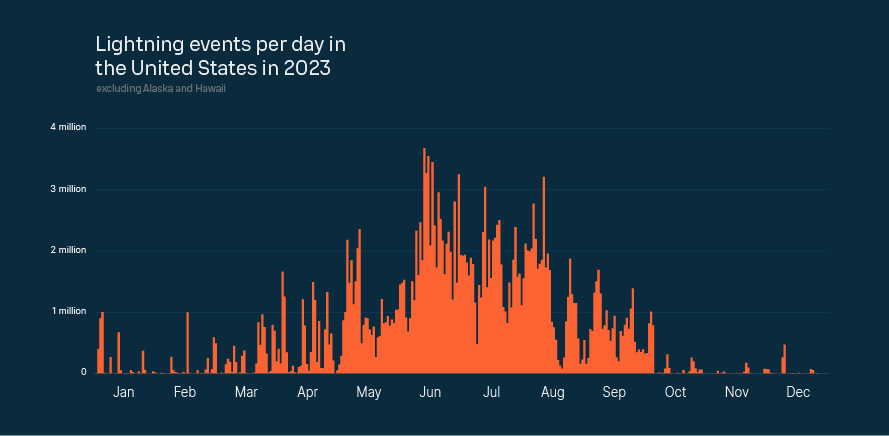New insights from 2023 help wind farm operators prepare for the 2024 lightning season.
Every wind farm operator knows that lightning is a serious risk. But until now, energy companies, investors, and traders have not had a complete view of lightning risk for the U.S. wind energy industry in its entirety.
We analyzed a full year of lightning activity around 75,000 wind turbines in more than 1,500 U.S. wind farms to answer three critical questions:
How often does lightning strike wind turbines?
Where are wind farms most at risk from lightning?
How can the wind energy industry manage lightning risk?
Our first-of-its-kind analysis identifies the full extent of lightning strikes at or near wind farms in the contiguous United States. Read on to discover what operators can learn from 2023 to prepare for the 2024 lightning season.

How often does lightning strike wind turbines?
We detected 77,494 lightning strokes at or near U.S. wind farms in 2023. That’s just over one for every turbine in the country on average. In reality, some farms saw significantly more lightning while some had no lightning at all, as we’ll see later in this post.
By the way, a lightning stroke is what we call the rapid discharge of electrical charge between a cloud and the ground. There can be several strokes in a single flash of lightning. Our lightning detection networks detect and locate lightning strokes worldwide with high accuracy and precision.
Wind farms are natural targets for lightning, due to their height and the conductive materials they contain. The taller the turbine, the more likely it is to be struck by lightning. And in the race for maximum efficiency, height does matter. According to the U.S. Department of Energy, the average hub height of land-based wind turbines has increased by 73% since 1998, to 98 meters (322 feet) in 2022. That's taller than the Statue of Liberty.

Where are wind farms most at risk from lightning?
Lightning in the United States is most common in the middle of the country and in the Gulf Coast states. The map below shows the number of in-cloud and cloud-to-ground lightning events per square kilometer in 2023. We call this lightning density. Wind farms in areas with high lightning density are more at risk than those in areas with lower lightning density, such as the Northeast and West Coast states.

Our analysis discovered that 31% of U.S. wind farms had one or more cloud-to-ground lightning strokes per turbine in 2023. Conversely, 33% of wind farms got through the year without a single lightning strike.
A wind farm in Pushmataha Country, Oklahoma, earned the unenviable top spot with an average of 14.4 lightning strokes per turbine, followed by a wind farm in Freeborn County, Minnesota, with 12 lightning strokes per turbine. In total, three wind farms received more than 10 cloud-to-ground lightning strokes per turbine on average in 2023.
In raw numbers, a wind farm in Hansford County, Texas, and another straddling Blaine and Custer Counties, Oklahoma, saw more than 1,000 lightning strokes each last year. Our Annual Lightning Report reveals the locations of the top 20 most lightning-prone U.S. wind farms in 2023.

How can the wind energy industry manage lightning risk?
Wind turbines have lightning protection systems that channel electrical energy safely into the ground. In fact, industry experts estimate that wind turbines survive 97–99% of lightning strikes without taking any significant damage.
Even so, the 1–3% of damaging lightning strikes cost the industry $100 million annually and account for 60% of blade losses and almost 20% of operational losses overall, according to estimates.
Risk management company DNV says lightning damage is the single largest cause of unplanned downtime in wind turbines. Insurance specialist AXIS Capital says lightning damage also results in the longest downtime at 233 days on average per closed claim.
“Renewable energy is the key to the future of our energy mix, and overcoming obstacles like lightning risk is a central part of enabling large-scale expansion and reducing our dependence on fossil fuels. With our lightning capabilities, we give wind farm operators the tools they need to place power generation in the right locations and protect their operations from downtime and unnecessary pauses in production.”
Ryan Said, Senior Scientist, Vaisala Xweather
Vaisala’s precision lightning detection network detects lightning in real time, pinpointing the location of each event to within 100 meters in the contiguous United States. Vaisala also operates the world’s most consistently accurate and reliable long-range global lightning detection network supporting wind farms anywhere on Earth, including offshore installations.
Energy companies rely on this high-quality lightning data to understand the frequency and severity of lightning activity when evaluating sites for new projects. Understanding the risk reduces the uncertainty of forecasting lightning-related operational expenses.
Monitoring severe weather is crucial for keeping wind farms operational. Automated lightning alerts help technicians and other on-site personnel stay safe when storms are nearby. Xweather provides real-time severe weather monitoring and automated lightning alerts for any location worldwide.
We also measure and report the peak current of lightning strokes and help operators identify lightning events with the highest strike damage potential. This capability empowers wind farm operators to efficiently prioritize inspections and maintenance after a thunderstorm to minimize costly downtime.

Are you ready for lightning season?
Lightning is highly seasonal in the United States. Thunderstorms start increasing in frequency in May and peak in the summer months before quieting down by October. Five of the top ten lightning days in 2023, all falling between June 14–21, each saw more than 3 million lightning events in a 24-hour period.
The 2024 lightning season is coming. Contact us today to learn how Xweather can help you protect your assets and personnel and optimize your operations against severe weather.
